HMS Queen Elizabeth and her Carrier Strike Group has met with the USS Ronald Reagan, the USS Iwo Jima and their escorts.
The Queen Elizabeth and Ronald Reagan Carrier Strike Groups, alongside the Iwo Jima Amphibious Ready Group, conducted a large scale joint interoperability exercise in the Gulf of Aden, July 12th.
200,000 tons of integrated, all-domain naval power! "Tri-Flat Top" ops with HMS QUEEN ELIZABETH (R08), USS RONALD REAGAN (CVN 76) and USS IWO JIMA (LHD 7) in the U.S. Central Command region, deterring aggression, protecting freedom of the seas, and ensuring regional stability. pic.twitter.com/wIgNOOT9m3
— U.S. Naval Forces Central Command/U.S. 5th Fleet (@US5thFleet) July 12, 2021
The U.S. Navy say that the combined, bilateral surface, air and sub-surface exercise was designed to enhance UK, Dutch and U.S. maritime interoperability and demonstrate naval integration through a series of training scenarios.

“Our team was proud to operate alongside the UK Carrier Strike Group during this unique opportunity to hone the full scope of our mutual capabilities,” said Rear Adm. Will Pennington, commander, Ronald Reagan CSG and Task Force 50.
“By operating together at sea, we deepen our coalition partnerships and extend our global reach throughout the region’s critical waterways.”
The crews exercised their abilities to conduct precision maneuvering, hunt simulated enemy submarines, provide layered defense against simulated air and surface threats, and conduct long range maritime strikes against simulated adversarial forces.
“The aircraft carrier is the ultimate expression of global maritime power,” said Commodore Steve Moorhouse, commander, United Kingdom Carrier Strike Group.
“Queen Elizabeth, Ronald Reagan and Iwo Jima symbolise the might of the U.S. and UK partnership, and the ease with which our naval and air forces can combine here in the Gulf of Aden, or anywhere else in the world.”
This also marks the second time this year the Iwo Jima ARG has operated alongside the UK carrier strike group, following an exercise off the coast of Scotland in May.
“Participating units included aircraft carrier HMS Queen Elizabeth (R 08) with embarked F-35B Lightning II Joint Strike Fighters from Royal Air Force 617 Squadron and U.S. Marine Corps Fighter Attack Squadron (VMFA) 211; aircraft carrier USS Ronald Reagan (CVN 76)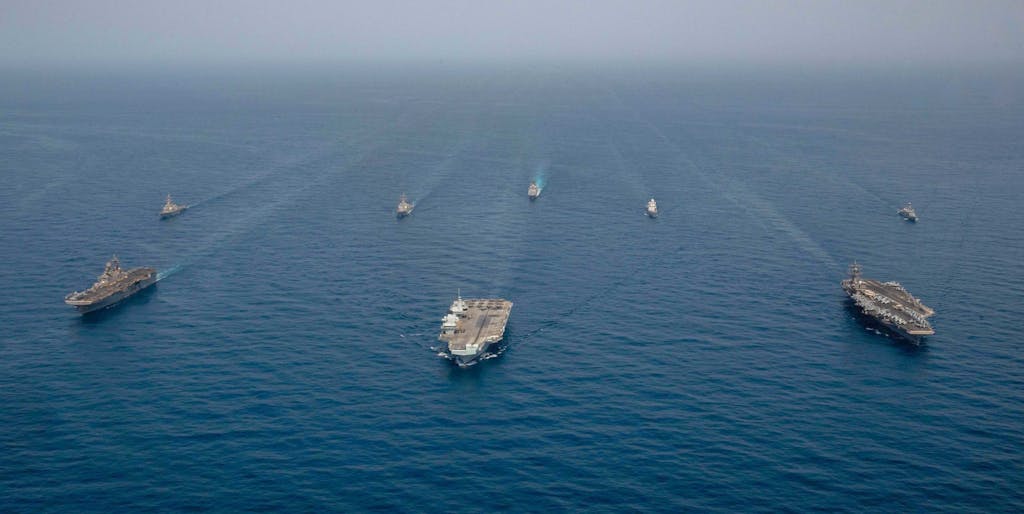 with embarked Carrier Air Wing (CVW) 5 and Destroyer Squadron 15; amphibious assault ship USS Iwo Jima (LHD 7) and embarked 24th Marine Expeditionary Unit (MEU), anti-submarine frigate HMS Richmond (F 239); Dutch frigate HNLMS Evertsen (F 805); guided-missile destroyers USS The Sullivans (DDG 68) and USS Halsey (DDG 97); and guided-missile cruiser USS Shiloh (CG 67).”
with embarked Carrier Air Wing (CVW) 5 and Destroyer Squadron 15; amphibious assault ship USS Iwo Jima (LHD 7) and embarked 24th Marine Expeditionary Unit (MEU), anti-submarine frigate HMS Richmond (F 239); Dutch frigate HNLMS Evertsen (F 805); guided-missile destroyers USS The Sullivans (DDG 68) and USS Halsey (DDG 97); and guided-missile cruiser USS Shiloh (CG 67).”
The U.S. Navy say that the Ronald Reagan CSG and Iwo Jima ARG are deployed to the U.S. 5th Fleet area of operations in support of naval operations to “ensure maritime stability and security in the Central Region, connecting the Mediterranean and the Pacific through the western Indian Ocean and three strategic choke points”.


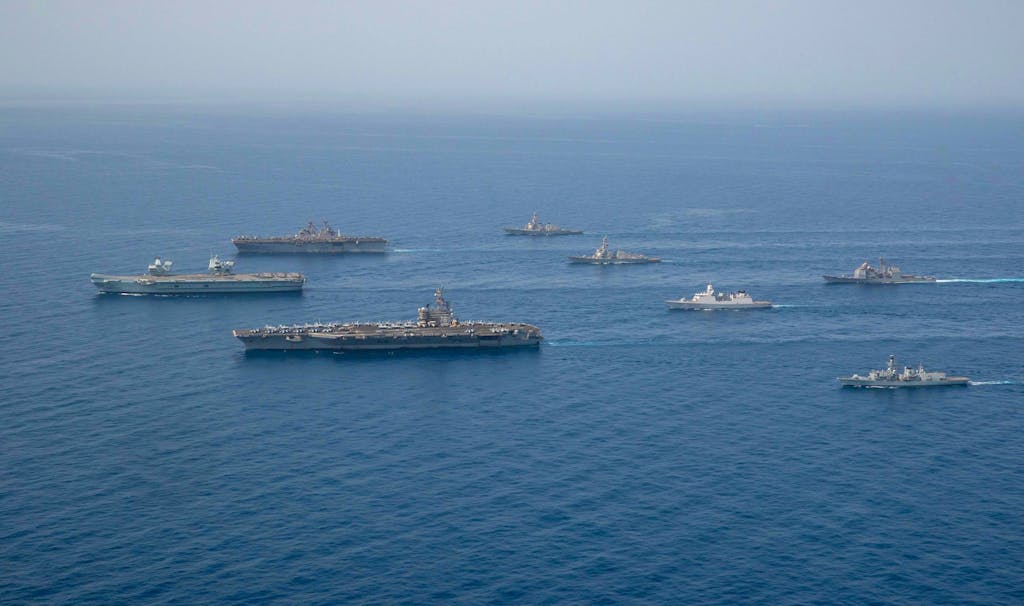
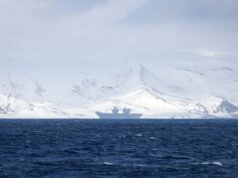
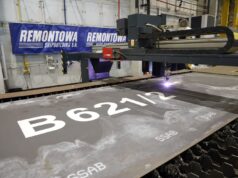
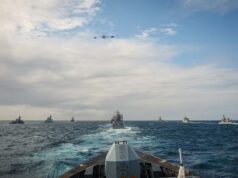


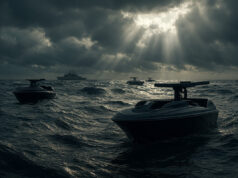
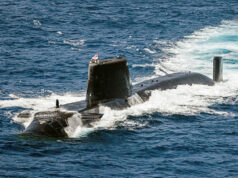

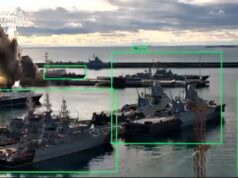
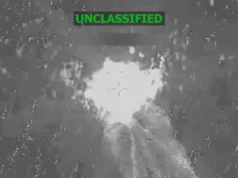

AWESOME.
Shame that the rest of the escorts couldn’t be there for the photex.
I mean the F-35’s that are lined up in a triangle formation look pretty cool. Wonder what it must of looked like directly above the ship
Probably pretty similar but from a slightly different angle.
Reminds me of WW2 parking arrangements. What a formidable sight these vessels make, considering neither Russia nor China could find other countries happy to combine efforts, like this RN global deployment. These pictures show how powerful nations can be when they work together both within NATO and friendly non-members.
Have to say Iwo Jima ! Doesn’t look out of place in that company. That’s an Amphib bloody hell.
She’s almost exactly the same size as Charles deGaulle. The America class are actually larger than CdG.
Absolutely David, our American cousins don’t do things on the cheap.
Wonderful to see such a powerful integrated battle group…
Yes. its not much shorter but definitely less beam. so 25000 tonnes less. Deceptive, it looks much bigger.
Shame we cannot have a couple of similar ones, sigh.
If we did we probably wouldn’t have the QE’s…
For what purpose?
I’d be relatively unsurprised if we got 2 x platforms that can launch and recover UAV’s that looked a bit like a slimmer Ocean but that could move at CSG speeds.
That is the problem with amphibs they don’t go fast.
Is the speed problem down to the fact they are designed with well decks?
Agreed, I would live to see two or possibly three HMAS Canberra type ships to replace Albion, Bulwark and Ocean.
When I took a quick look at the photo I thought it was an old aircraft carrier! Makes me wonder if it could actually carry F-35s if need arose.
Oh yeah read somewhere that one of the reasons they don’t use ski jump is because USN are worried that they would be seen by US politicians as a viable and cheaper alternative to their Carriers. If I read that on this site I’d like to apologise to those concerned.
No, the reason the US LHD’s don’t use ski jumps is because they’re primarily there to launch Marines onto the shore via helicopter. Adding a Ski Jump would make their fast air more effective but would remove one of the Helicopter landing/takeoff spots. A trade off the USMC and USN aren’t willing to make (given the 11 supercarriers probably understandably).
Iwo Jima wouldn’t be able to carry F-35’s btw, she, along with the rest of the Wasps don’t have the heat resistant flight decks to handle them, but the incomming America class LHD’s that will replace them do.
Did not know that about F35’s. I think I said one of reasons was USN
Oh yeah, I just meant it was a choice based on operational priorities, rather than political backroom dealing.
USS Wasp and USS Makin Island both carry F-35B.
It’s not a picture of USS Wasp, it’s USS America, both LHD’s but America is newer and slightly larger.
*edit* Easiest way to tell is to look at the funnels IMO, Wasps have small and vertical funnels, Americas have larger funnels going off at a 45* angle.
USS Wasp deployed in 2019 with 10 F-35Bs. USS Makin Island and Essex also now carry F-35Bs. Not sure what that has to do with the picture you posted. They are both capable of carry F-35Bs now. That is all I was referring to regarding your post that said Wasp class ships cannot currently operate F-35Bs.
Dan, you edited your comment. You know you did. Stop lying, it’s pathetic.
You originally said “That’s a picture of USS Wasp isn’t it?”
I corrected that, and then YOU edited your comment and pretended like I made a different response.
How is their F35B ops affected by the lack of ski jump? Do they just have to lower the takeoff weight?
The US Navy claimed it would cost 3 helicopter landing spots. This is clearly untrue unless they build a massive ramp encompassing the full width of the flight deck, which leads me to suspect that they are indeed (to some extent) downplaying the practicality for political reasons.
Agreed 3 is a bit of a worst case scenario, but I can definitely see at least 2 going. A 14 degree ramp would at least take out Landing spot #2 and make landing in #1 hazardous, and potentially create issues with #4 or #3?
But even loosing 2 represents nearly a 1/3rd reduction in helicopter launch capacity, and since the LHDs/LHAs are primarily about putting Marines ashore on Helicopters, still remains a pretty valid reason.
Happy to be corrected if I’m wrong but I believe even QE’s and Invicibles didn’t use the area to starboard of the ski ramp for helicopter take off/recovery.
USS Boxer is currently in refit with part of the work upgrading to F35B capability. She will be the fifth Wasp class ship to be upgraded.
Interesting. What are the remaining 2 then? Iwo Jima and…? Bataan?
Hard to get the actual names, but likely the two you have named.
It has F35s on deck in the picture
Iwo Jima doesn’t have F35’s in this picture, the fighters on deck are Harriers.
It’s the plan for all of them to in time. Some have already been converted and conducted flight ops with F35Bs. They’re mini-carriers for the USN.
Best not to mess with them ,looking 👹indeed
If the Uk is to continue ‘projecting’ that far from home, is it time for another UK Carrier to use nearer home?
In addition to HMS Prince of Wales you mean?
Yes
Yeah 3 would be very nice but I think we need to concentrate on getting there airgroups up to capacity. Say 24 F35’s on 1 in peacetime and same on both in emergency. At $100m a pop that’s not going to be cheap.
Yes we should have built 4 I think
1 for home waters, reserve, and training
and 3 for overseas
Wishful thinking on extra assets as usual 🤓
Good to see progress on the carrier ops
In the politest terms, no. There is an argument for having a couple of helicopter carriers, as one of the duties they could carry out is asw north of the UK (similar to our set up in the cold war), and if they were build to similar specs as HMS ocean the costs could be reasonable. Taking into account the cost of another QE carrier and what it’s actually used for, it’s simply not worth having a third one to use closer to the UK. Bearing in mind maintenance and training times two carries is ample to ensure we always have one ready. If someone gave the RN another 3.2 billion to spend I think there would be quite a bit they would get before another carrier.
Was just a thought really, as given 10 years ago, one was to go into service, and the other ‘mothballed’ if I remember the term used correctly. That was from the tory party, who also suggested when they got in, that they could even cancel the order.
It’s great to speculate around these things as that generally drives people to find more out around the subject. Whilst three QE carriers or even 4 would be excellent theres simply many more other things that we need as a higher priority and that would give us better capability.
Yes I firmly believe if they hadn’t had their hands tied they would have ended up only building 1 carrier, which wouldn’t have been enough.
The main issue with 2 is providing enough supporting ships and subs for both whilst providing adequate ships for our other global duties (this was one of the drivers around them wanting only 1 carrier)0. As things stand, if both ships are fully supported this will leave us with mostly type 31 ships for other global duties, essentially creating a two tier fleet. Personally speaking, I’m hoping this conundrum will drive up numbers of our higher spec ships but we’ll see. I imagine what they will actually do Is have one fully supported QE carrier deployment, with the other kept in reserve for emergencies. That way the ships that would be used to support the second one can be sent elsewhere on other missions.
Agreed.
Increasing the escort fleet is a more pressing need.
Magnificent Photograph’s.
I’m guessing there’s a US or UK sub(s) lurking nearby.
The UK CG includes a sub.
So does the US group
This really is awesome – but where are the Type 45s?
We sold them i think. LOL
well I am glad this is only in jest.. 🙂
There are a lot of joint exercises and defence diplomacy visits going on around CSG21 – Defender is the Gulf, not sure about the others.
sad news about DIAMOND’s turbine OPDEF (not to mention the death in KENT). I had a feeling something was up. Hope they sort it soon.
Something pops up where the UK and US have to go their own ways – where is our AAW platform?
The idea is great but the resourcing is inadequate, UK CSG can not stand alone and perform. It is very poor and shows a fantastic Royal Navy underfunded by the pollies.
The Type 45s are AAW ships.
where are the type 45 ?
The publicity shots are concentrating on the flat tops, not often you get three together…
guided-missile destroyers USS The Sullivans (DDG 68) and USS Halsey (DDG 97); type 45 not in there,where are them
How big a picture do you want.
Old I have been listing the ships in the carrier group ad nauseam.
Ones in Sicily with a blown GT.
Straight forward change out WR21 is modular so you can change parts of it without having to ship out the whole thing.
The defect is GT related and nothing to do with the issues T45 had with recouperators in hot weather. GTs break. Changing them is a well trodden path for RN maintenance teams.
Hang on… A USN Carrier and an Amphib Group with only an AB and a Tico as Escort…
How can they survive against a near peer adversary with only 2 escorts neither of which is particularly ASW orientated and don’t have AAW radars that are AESA equiped?
🤔😉
the article says Destroyer Squadron 15, which is made up of 7 ABs; none of which are specifically listed. So I guess they are hanging around somewhere.
Destroyer Squadron 15 is the Staff group on the carrier
RR and the ARG currently has 1x AB and a Tico with it.
There is another Tico in and around the Gulf area along with an AB.
The Sullivans is part of CSG21
I have said before the USN doesnt usually have that big a group of escorts with a carrier. They dont even bother with allocating escorts for the ARG. Escorts are chopped in and out if and when required and mostly they are not, hence a carrier with maybe 3 Escorts
We have detached ships from our CSC. This is a cruise involving other things. I suspect we would not generally have much a large “fleet” on general patrol.
I think @GB was being a bit tongue in cheek?
That is an awesome grouping of firepower.
CAP – from the USN
CAS – from QEC
Hellos – LHD
Stir in the sorties that can be generated from the auxiliaries as well and you get quite some tempo going.
might almost do for an opposed landing. Sorry forgot those are out of fashion. Remind me how do you land an MBT…..the ones we have just decided to upgrade…..let’s just hope we are all best of friends with the locals when we need to land one.
The total missile load out on that lot would flatten pretty much anything anywhere.
Something like this.
I was being a bit tongue in cheek.
The review basically binned contested landings.
My myopic view is that there is no clear cut contested/uncontested and that any landing will be interfered with somehow.
So what I’m saying is that NATO does need a hardened landing capability in the round. And it is pretty bizzare giving that up given that QEC + F35B + Apache is close to the perfect support for landings. Particularly as part of a NATO package with a USN flattop and Gator components.
The type 45s and Arleigh Burkes will be a few miles out of shot, doing their job of defending what is a rather vulnerable situation for the flat-tops during the photo-op.
There are exactly two type 45s they can go to see at the moment and one of them is allegedly somewhere around the CSG-21….
Shock horror GB…….;0
Nice to see HMLMS Evertson in the frame. The Dutch are reliable contributors with very capable AAW ships.
They certainly are, they always answer the call, as do the Danes and French.
Were lucky to have such steadfast allies.
I did predict this would happen 😄
What/how many escorts does a US LHD typically sail with?
Normally an ARG is a flat top, a San Antonio LPD and a Dock Transport. No dedicated escorts. They cut in and out of the ARG depending on where it is in the world.
The one out this way earlier in the year had an AB attach itself for a bit… But mostly the ARG ships where on their own.
The Wasp class are great ships and I used to advocate that rather than two 65,000t STOVL carriers each able to operate three squadrons of 12 F-35B’s, the RN should have gone for three 40,000t LHD’s similar to the Wasp’s, each able to carry a single squadron of F-35Bs in addition to embarking a Commando Group. I’ve since become jaundiced about the value of very large amphibs – unless you are a superpower that can afford both these and even bigger carriers. In a high intensity war they are very vulnerable, whilst for low intensity conflicts and peace-time operations in support of civilian authorities, much cheaper options will often suffice.
It’s very reassuring to know the west has the capabilities to defend itself, and support other vonurable countries in times of intimidation and hostilities